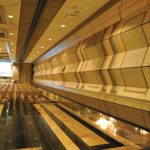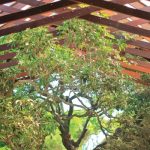
Bodhisattva Avalokiteśvara – A unique wood carving made of teak and painted with gold dust exhibited at Rajanima Craft & Gallery at Kandy
By Leel Pathirana
Wooden architecture and wood carving are inextricably linked in the traditional wooden architecture of Sri Lanka, especially in Kandy, the Central Province of the country. The allied skills simultaneously highlight the construction and carving skills of master-craftsmen and architects; Kandyan wooden architecture is extremely rich in detailing, showcasing a range of wood-carving, much of which represents a remarkable combination of creativity and skill in manipulating the material.
Wood carving in Sri Lanka has a long history. The tradition of wood carving in Sri Lanka is manifested at Lankathilaka, Gadaladeniya Temple and Embekke Devale at Kandy. Wood carving industry is believed to have been used first for temples in Sri Lanka at the beginning of early 1357 AD. One of the best known places for splendid Sri Lankan woodcarving is Embekka Devalaya (Embekka Temple), built by King Vikramabahu III during the Gampola Era (AD 1357 – 1374) and which can be witnessed even today. Some examples of medieval masterpieces of wooden architecture that have survived, almost intact, are the roofs and pillars of the Embekke Devalaya, the Audience Hall of Kandy, and the Ambalamas or resting places.
Examples of elaborately detailed wooden architecture of the 18th Century are located mainly in and around Kandy in the Devales, Viharas (Buddhist Temples) and Maligas (palaces). Sumptuary laws forbade elaborate domestic architecture in ancient Sri Lanka. Only the king’s palace and religious buildings were allowed to have doors with ornamental tops and lime plaster. Dwellings of ordinary citizens had thatched roofs, though those of the highest rank were permitted to have tiled roofs.
Mastering the skill of wood carving often precedes initiation into carving ivory, an extremely delicate and esteemed craft
These unique works were assigned by the king(s) for separate families at that time, who were skilled at producing wood carvings. Later these works expanded, inherited from generation to generation, up to the present times. The abundance of several varieties of timber was instrumental in the prolific presence of wooden architecture. The traditional craft of wood carving was practiced by several highly esteemed craftsmen and master-craftsmen, who trained apprentices in the principles of the craft.
Mastering the skill of wood carving often precedes initiation into carving on ivory, an extremely delicate and esteemed craft. There is a strong link between the two crafts: once an artisan carving on wood has graduated to ivory-carving he is believed to have reached the pinnacle of his craft. The descendants of master ivory carvers of yore carve in wood when ivory is not available.
Each carving has a historical value, name and a story. There are 126 different decorations, 256 patterns of ‘liyawel’ and 64 lotus flower designs—these are the features used by the craftsmen. Even few of the floral designs are added to the Ordinary Level syllabus.
The ancient wood carvers were not only skilled at carving, but they were also taught to preserve these works of art using natural wood preservatives made out of different ingredients. That is how these works of art have lasted for centuries.
It is believed that they have made a unique preservative from Rata Dummala (resins) powder mixed with Kekuna Maliyam (gum from the Kekuna Tree). Dummala is a dead wood dug out from the ground and is a fossilised plant material and the glue is taken from the Kekuna tree.
There were ancient traditions of cutting trees for wood carvings and seasoning, in the earlier periods. Mature trees were first selected. Then an auspicious date and time were chosen astrologically in order to cut the tree. Before cutting it down, they perform ancient rituals and pay homage to the Gods—chanting spiritual mantras before the tree, lighting coconut oil lamps with incense sticks.
Another factor to consider when cutting a tree is to select a full moon day. On the full moon day, sugar content or the sugar level of the tree goes down. When there is a low sugar level in the tree, the timber will not be attacked by destructive wood boring insects. Same as the human body, a tree has a certain level of sugar contained within it.
Modern wood carving
Wooden sculptures have become a popular craft item, owing to increased demand from visiting tourists. This has encouraged the carvers with special skills of carving and sculpting to create similar figures of humans and animals in flat or round shapes, individually and in groups. The themes for these sculptures not only include statues of Buddha and gods but also compositions of scenes and events drawn from local history, legend, and contemporary life.
The products are usually carved from hard woods such as Ebony, Palu, Mara, Mahogany, Sandalwood, Gam-malu, and Na, which are close-grained woods. Statues of Buddha are usually carved out of Mahogany and Teak. Sandalwood is rich and much more expensive. The tools used to make figures out of wood include simple items such as hand-saws, chisels of various sizes, mallets, and a divider and square. An adze is used for shaping the log, and chisels of different sizes and shapes are used for carving.
A piece of wood is first selected and a rough shape is chiseled out on it through a process known as baragahanawa. After this, the actual features are delineated: this process, executed with fine chisels is known as mattangahanawa. This image is then smoothened out and polished.
This industry in it’s present day has become commercialised and mainly cater to the tourism market. All the wood carvings and handicrafts are sold for tourists alone. Still this unique profession continues from generation to generation, up to the present days within these families. Villages such as Embekke, Lankathilaka and Gadaladeniya are the most prominent for Kandyan wood carvings. Additionally the Kala Puraya was also set up and the people are trained and assisted by the National Craft Council or Jathika Shilpa Sabhawa by the Government.
















